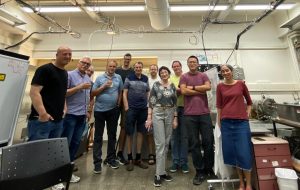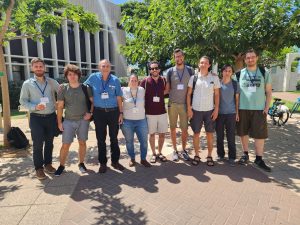

Plasma Physics and Pulse Power Laboratory – P4
The Plasma Laboratory of Physics Department Technion was established in early 1990s by prof. Prof. Joshua Felsteiner. From 1997 it named as Plasma Physics and Pulse Power Laboratory. Since then a variety of research projects related to current carrying pulsed plasma were carried out by graduate students supervised by Prof. Yakov Krasik and his colleagues from Israel and new-immigrant scientists from ex-USSR.
Plasma is considered to be the fourth state of matter (solid, liquid, gas, plasma and dark matter). In fact, plasma (electrons and ionized atoms) is present almost everywhere: inside planet cores, in stars, in the inter-stars space, in the upper layers of the atmosphere, etc. Without plasma one cannot image a modern world: plasma is a key component in the production of electronic boards for computers, in lightening diverting devices, in TV’s. Plasma is used for disinfection purposes in medicine and for the modification of material surfaces. However, the main interest in plasma is related to the production of electrical energy using thermonuclear fusion reactors. In fact, this seems to be the only method which can supply efficient and clean electrical energy in our increasingly demanding world.
In the Plasma and Pulsed Power laboratory we are carrying out research on various plasma sources which can be used for the generation of relativistic and high-current electron beams. These beams can efficiently transfer their energy to high-power microwave radiation and the latter can be used to transfer energy over long distances without the use of cables. Also, we are studying the interaction of such extremely high-power radiation (hundreds of Megawatts) with plasma resulting in intriguing non-linear effects not studied so far. Additional research is related to the generation of extreme states of matter and non-ideal plasma which is realized during underwater electrical explosion of wires and wire arrays. In these experiments pressures up to several tens of Mega Bars are realized similar to those expected in giant planets and stars. This research is extremely important to the verification of various conductivity models and Equation of States and is in the regime known as warm dense plasma. All experimental research is supported by complicated magneto-hydrodynamic modeling as well as electrodynamic and Particle-in-Cell modeling of the processes occurring in plasmas.
The laboratory is well equipped with unique pulse power generators operating at peak power up to tens of GW and current amplitudes up to 1 Mega Amperes in a timescale from nanoseconds to microseconds. To diagnose the plasma, microwaves and charged particle beams, various time- and space-resolved optical, x-ray, microwave, laser and spectroscopic diagnostics are used.
The results of our research can be found in leading physics journals like PRL, APL, PoP, JAP, and IEEE Trans. Plasma Science, etc. Our graduate students publish 8 papers on average annually. 20 Ph.D. and 12 M.Sc. students have graduated (2022) from our laboratory and work at present in hi-tech companies and National Institutes in Israel and abroad. Our graduates have been accepted as postdocs in leading world-recognized scientific laboratories such as the Imperial College and the Princeton Plasma Physics Laboratory. Four of our students have received prestigious highly competitive international awards. Most of the students received awards and science honor prizes and their papers were noted in physics international and Israel conferences.
Experimental and theoretical P4 researches include
- Non-stationary current-carrying plasma. Passive plasma sources
- Explosive emission plasma sources
- Flashover plasma sources
- Multi-capillary plasma sources
Active plasma cathodes
- Hollow cathode and hollow anode plasma
- Sources, ferroelectric plasma source
- Hollow cathode plasma sources for space applications.
- Non-ideal plasma studies using underwater electrical wire explosion.
- Generation of strong converging shock waves and extreme state of water using underwater cylindrical wire array explosion.
- Research of Run Away Electrons generation in pressurized gas high voltage and high current electrical discharges.
- Influence of the cathode and anode plasma dynamics on generation of high power microwaves in relativistic magnetron and vircator.
- Physical processes accompanying high-power ion/electron beam generation.
- Design and development of high-power generators, electric probes, nuclear activation methods, laser, optical and spectroscopic measurements.
Experimental setups and facilities P4 consists from
- 4 experimental laboratories with a total laboratory space of around 400 m2.
- several pulsed power generators with output power up to 1010 W, stored energy up to 10 kJ operating in sub-nanosecond – microsecond time scales, in single and rep-rate modes.
- experimental electrical, optical, spectroscopic, laser interferometry, Thomson scattering, laser induced fluorescence, and X-ray diagnostics equipment

